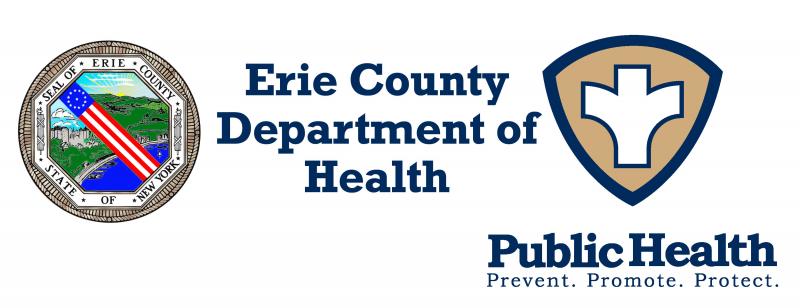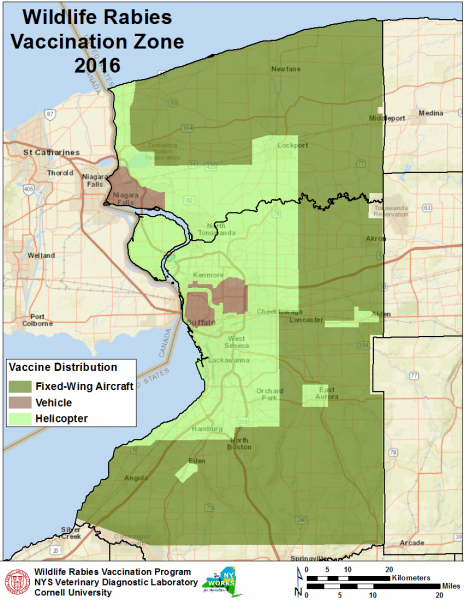Modified: August 16, 2016 1:46pm
Latest News

PRESS RELEASE
From the Office of the Commissioner of Health, Dr. Gale R. Burstein
Date August 11, 2016
CONTACT: Mary C. St. Mary/Mary.StMary@Erie.Gov
Phone: 716.858.4941/ Mobile: 716.253.3925
Rabies Vaccine Airdrop Efforts to Begin Mid-August
Program Aimed at Reducing Incidence of Rabies in Local Wildlife Population
ERIE COUNTY, NY— In collaboration with the Cornell University Animal Health Diagnostic Center, the New York State Department of Health and the USDA/APHIS Wildlife Services, the Erie County Department of Health (“ECDOH”) is participating in a wildlife baiting rabies vaccination initiative.
Beginning on approximately Thursday, August 18, 2016, rabies vaccine baits will be distributed over rural areas by five fixed-wing aircraft and in suburban and open areas of the City of Buffalo by two helicopters. Based on weather conditions, it will take approximately 3 days to complete this phase of the program. In addition, the ECDOH Division of Environmental Health staff from the Rabies, Disease and Vector Control Program will distribute baits via vehicles and on foot, beginning around August 22nd. The geographic area to be covered is shown on the attached map.
“This distribution of vaccine-laden baits by airplane and helicopter throughout Western New York is part of an aggressive action to halt the spread of rabies in wildlife, particularly raccoons,” said Peter Tripi, Senior Public Health Sanitarian. “Rabies remains a very serious disease as it is nearly always fatal once symptoms are evident. Coordinated efforts such as this are a vital way to protect Erie County residents and their pets from contact with potentially rabid wildlife.
To date in 2016, 17 animals from Erie County tested positive for rabies, predominantly raccoons. Vaccinating wildlife against rabies is a highly effective way to decrease the risk of exposure to rabies by coming in contact with rabid wildlife.”
“The ECDOH Rabies, Disease and Vector Control program will be actively putting boots on the ground to hand bait areas throughout Erie County,” said Dr. Gale R. Burstein, Erie County Commissioner of Health. “Be on the lookout for our team helping to fight the spread of rabies. The oral rabies vaccine will hopefully lead to a drop in rabies in our raccoon populations. Our goal is decreasing Erie County residents’ risk of coming in contact with a rabid wild animal.”
Residents should not disturb baits if they see them. Most baits are eaten within four days; almost all baits will be gone within a week. If baits are not found and eaten, they will dissolve and expose the vaccine; sunlight and exposure to air then inactivates the vaccine. If you must move the bait, wear gloves or use a plastic bag or paper towel when picking it up. Place any damaged baits in the trash; throw intact baits into a wooded area or other raccoon habitat. Residents should WASH HANDS IMMEDIATELY if they come into direct contact with the vaccine or bait, then call the New York State Department of Health Rabies Information Line at 1-888-574-6656.
Other recommendations include:
• Supervise children’s outdoor activities during and for one week following bait distribution
• Confine dogs and cats indoors and observe leash laws during the bait distribution interval and for one week afterward. This increases the probability of raccoon vaccination and decreases the chance of pets finding the baits
• The baits and vaccines are not harmful to domestic animals; however, an animal may vomit if it consumes several baits. Residents should not risk being bitten while trying to remove bait from your pet’s mouth.
# # #
For More Information:
Erie County Department of Health
New York State Department of Health
Centers for Disease Control and Prevention
United States Department of Agriculture Animal and Plant Health Inspection Service,



